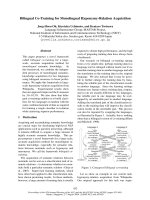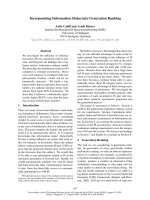báo cáo khoa học: " Translating clinical training into practice in complex mental health systems: Toward opening the ''''Black Box'''' of implementation" docx
Bạn đang xem bản rút gọn của tài liệu. Xem và tải ngay bản đầy đủ của tài liệu tại đây (228.94 KB, 7 trang )
BioMed Central
Page 1 of 7
(page number not for citation purposes)
Implementation Science
Open Access
Debate
Translating clinical training into practice in complex mental health
systems: Toward opening the 'Black Box' of implementation
Greer Sullivan*
1,2,3
, Dean Blevins
1,2,3
and Michael R Kauth
1,4,5
Address:
1
South Central Mental Illness Research, Education, and Clinical Center (SC-MIRECC), Central Arkansas Veterans Healthcare System,
North Little Rock, USA,
2
Central Arkansas Veterans Healthcare System, HSR&D, Center for Mental Healthcare and Outcomes Research (CeMHOR),
North Little Rock, USA,
3
University of Arkansas for Medical Sciences, Department of Psychiatry, Division of Health Services Research, Little Rock,
USA,
4
Michael E. DeBakey Veterans Affairs Medical Center, Houston, USA and
5
Menninger Department of Psychiatry & Behavioral Sciences, Baylor
College of Medicine, Houston, USA
Email: Greer Sullivan* - ; Dean Blevins - ; Michael R Kauth -
* Corresponding author
Abstract
Background: Implementing clinical training in a complex health care system is challenging. This
report describes two successive trainings programs in one Veterans Affairs healthcare network and
the lessons we drew from their success and failures. The first training experience led us to
appreciate the value of careful implementation planning while the second suggested that use of an
external facilitator might be an especially effective implementation component. We also describe a
third training intervention in which we expect to more rigorously test our hypothesis regarding the
value of external facilitation.
Results: Our experiences appear to be consonant with the implementation model proposed by
Fixsen. In this paper we offer a modified version of the Fixsen model with separate components
related to training and implementation.
Conclusion: This report further reinforces what others have noted, namely that educational
interventions intended to change clinical practice should employ a multilevel approach if patients
are to truly benefit from new skills gained by clinicians. We utilize an implementation research
model to illustrate how the aims of the second intervention were realized and sustained over the
12-month follow-up period, and to suggest directions for future implementation research. The
present report attests to the validity of, and contributes to, the emerging literature on
implementation research.
Background
There is an ongoing need within healthcare systems to
train clinicians to deliver evidence-based care, particularly
when clinicians are well past their initial training. Educa-
tional programs may be especially challenging in mental
health because adequate training in many therapeutic
techniques, such as cognitive behavioral therapy or psy-
chosocial rehabilitation skills, is typically time consuming
and labor intensive for both the trainer and trainee. Once
clinicians are trained, implementing new practices in
treatment settings in complex health systems poses addi-
tional challenges [1-3].
Published: 3 June 2008
Implementation Science 2008, 3:33 doi:10.1186/1748-5908-3-33
Received: 29 June 2007
Accepted: 3 June 2008
This article is available from: />© 2008 Sullivan et al; licensee BioMed Central Ltd.
This is an Open Access article distributed under the terms of the Creative Commons Attribution License ( />),
which permits unrestricted use, distribution, and reproduction in any medium, provided the original work is properly cited.
Implementation Science 2008, 3:33 />Page 2 of 7
(page number not for citation purposes)
In this debate paper, we describe a series of training inter-
ventions for mental health providers undertaken by the
Department of Veterans Affairs (VA) South Central Mental
Illness Research, Education, and Clinical Center (SC
MIRECC) in a large, geographically dispersed network of
care, Veterans Integrated Service Network 16 (VISN 16).
The experience we gained from these interventions has
informed our thinking about training and implementa-
tion basics. Now we are preparing to test some of the
implementation components that we have delineated
through our direct experiences.
The first intervention consisted of a basic training experi-
ence for clinicians, but its implementation into practice
appeared limited by inattention to contextual issues. This
experience led us to make a distinction between 'training'
and 'implementation' phases of the intervention. The sec-
ond intervention, designed with greater attention to con-
textual implementation issues, utilized facilitation to
promote both training and implementation phases, and
found much wider uptake into clinical practice. Our suc-
cessful experience with the second intervention prompted
further refinement of our intervention facilitation model,
and we consequently identified a distinction between
internal and external facilitation. Finally, our third inter-
vention will open the 'black box' of intervention by sys-
tematically examining the value of external facilitation. To
date, most large-scale effectiveness research has compared
multi-faceted training and implementation efforts to
treatment as usual conditions. Testing specific interven-
tion components like external facilitation will enable us
to open the black box of multi-faceted training and imple-
mentation and examine the value of specific components.
Setting
One of the largest VA networks, VISN 16 serves approxi-
mately two million veterans across an eight-state region
from Oklahoma to the Florida panhandle. Mental health
services are coordinated by the network mental health
product line manager and the advisory council comprised
of the Directors of Mental Health at ten medical centers.
These ten medical centers offer both inpatient and outpa-
tient care, provided by more than 1,000 mental health cli-
nicians of various disciplines [4]. There is considerable
variation in the organization of the ten mental health
services. The SC MIRECC functions as a 'virtual' center
within VISN 16 and is charged with developing new
knowledge about mental illness and its treatment, and
with bringing new knowledge to bear on routine clinical
care. The SC MIRECC works closely with the network
mental health manager and the advisory council of men-
tal health directors to identify the primary training needs
of clinicians in the network and to implement training
programs. Each of the training programs described here
was developed in response to requests by the advisory
council of mental health directors.
Group therapy skills training
In 2001, faced with increasing demand for mental health
services coupled with little expansion in the number of
available mental health providers, the advisory council
asked the SC MIRECC to provide an educational interven-
tion to train providers in group therapy skills and tech-
niques. A substantial amount of literature attests to the
efficacy and effectiveness of group treatment modalities
[5,6], yet an assessment of 136 mental health providers in
VISN 16 indicated that only about one-third had any
training at all in group therapy methods. We naïvely
approached this training with the notion that an adequate
learning experience was key. We gave little attention to
implementation issues. Because the mental health leader-
ship across the VISN had specifically requested this train-
ing, we assumed that local mental health programs would
be invested in implementing the training.
Intervention design and content
The group therapy skills intervention delivered a two and
a half hour video conference on group therapy to mental
health clinicians at 10 VA medical centers in the network.
Clinicians at five of those medical centers (designated as
our intervention sites) received additional extended train-
ing consisting of an intensive two and a half day face-to-
face workshop, and eight monthly supervision conference
calls provided by the trainers. Trainings were based upon
a curriculum developed by the American Group Psycho-
therapy Association (AGPA) and were delivered by two
certified and experienced group therapists/trainers from
the AGPA program. In order to assess intervention effec-
tiveness, we designed the intervention to allow us to com-
pare the results of the extended training intervention with
a control group receiving only brief training. To identify
intervention and control sites, we examined key character-
istics of the ten participating network facilities, including
size of facility, number of patients, number of providers,
etc., and created five matched pairs of facilities. Within
each pair, an intervention site and a control site were ran-
domly designated.
Trainees
Clinicians who participated in the group therapy training
were selected by their local mental health director with no
input from the SC MIRECC. Clinicians (n = 136) located
across the ten medical centers watched the two and a half
hour videoconference and 36 clinicians at five sites
received the more intensive training. Of the clinicians
who received the intensive training, 8.3% (n = 3) were
physicians, 13.9% (n = 5) were psychologists, 38.9% (n =
14) were social workers, 30.6% (n = 11) were nurses, and
8.3% (n = 3) were a psychological technician, a physician
Implementation Science 2008, 3:33 />Page 3 of 7
(page number not for citation purposes)
assistant, and an occupational therapist. In a post-training
assessment, most trainees expressed satisfaction with the
training experience and stated that they planned to initi-
ate new groups in the next six months.
Outcomes – initial training
To assess the extent to which the group therapy training
was actually implemented in practice, we used VA admin-
istrative data to examine changes in the percentage of out-
patients receiving group treatment at each site, and the
percentage of outpatient visits that were conducted using
a group format at each site. Group treatment was defined
as psychoeducational, medication management, process,
and psychotherapy groups in general VA outpatient men-
tal health care clinics. PTSD and substance abuse pro-
grams were excluded because they typically provide
treatment in group formats. Changes in these measures
were studied at baseline (the three-month period prior to
training) and again at 12 months. We examined these out-
come measures in two ways, comparing results in each
pair of five facilities and comparing the five control sites
to the five intervention sites. We found no significant dif-
ferences in any of the pair-wise comparisons. Only two
sites (one control and one intervention site) demon-
strated increases in both outcome measures at 12 months;
the remaining sites had an unsystematic pattern of find-
ings. We concluded that the training had not resulted in
increased use of group treatments. As our initial aim was
to increase the amount of group treatments being deliv-
ered, we did not assess the quality of group treatments
that were delivered.
To understand why the training did not change patterns of
care, we evaluated key informant interviews that we con-
ducted post-training with 18 (50%) of the individuals
who had participated in the more intensive training pro-
gram. While most respondents stated that they valued the
training, they also expressed a desire for greater structure
and guidance in implementation and use of the follow-up
consultation calls. Trainees at one site felt that they were
forced to participate in the training but were not inter-
ested in doing so. Trainees identified several facilitators
and barriers to starting a new group during the 12-month
follow-up period, including administrative encourage-
ment and mandates. Barriers included lack of time to plan
and conduct additional group therapy sessions; practical
limitations, such as lack of space; patient hesitation to
participate in group therapy; and the lack of trained co-
therapists to assist with the groups.
Although trainees rated the group therapy training highly,
our evaluation suggested that simply providing training
and ongoing supervision, even when identified as a prior-
ity by local administrators, was not enough to actually
translate clinical training into everyday care. Even though
the SC MIRECC had invested considerable resources in
the training, practice patterns had not changed, and it is
likely that few patients benefited. We concluded that
future training interventions would need more attention
to, and facilitation of, both training and implementation
[7,8]. That is, training must be tailored to the trainees, and
both trainees and administrators must be actively engaged
in adoption of the new practice [3].
Psychosocial rehabilitation training
In 2003, as the VA began to emphasize a recovery-oriented
model of care [9], the network's mental health leadership
requested that the SC MIRECC coordinate and deliver a
training program in psychosocial rehabilitation tech-
niques. A survey of the ten mental health services found
that while limited rehabilitation services were offered at
the two largest medical centers, none of the ten medical
facilities provided a comprehensive psychosocial rehabil-
itation program. No network mental health clinicians had
received formal training in psychosocial rehabilitation
skills. We designed this next training effort with the les-
sons of the group therapy training in mind. We concluded
that part of our role as deliverers of training was to supply
the facilitation needed to translate the training to real
world application.
Intervention design and content
Because the need for training seemed clinically urgent
across our network, we elected to offer training across the
network and to use a simple pre-post design with no con-
trol group. The SC MIRECC training facilitator asked
trainees and their site mental health services directors to
create concrete and measurable goals for putting the train-
ing into practice, and we planned to assess the success of
the training by the extent to which each individual site
met its goals. One of the authors (MK) served as the SC
MIRECC facilitator and assumed the responsibility of
assisting with training and with local implementation
issues [10].
The SC MIRECC contracted with the Center for Psychiatric
Rehabilitation (CPR) to conduct psychosocial rehabilita-
tion training. The CPR training usually consists of four
semester-long courses at the University of Chicago and is
a train-the-trainer model, based on 125 core competen-
cies [11]. For our purposes, the CPR shortened the face-to-
face experiential portion of the intervention to five days
and provided two experienced trainers for on-site training.
However, prior to arriving at the training site, participants
were required to read four books and several articles as
background. Four months prior to the training, the SC
MIRECC facilitator began monthly conference calls to dis-
cuss the trainees' progress in the preparatory reading, their
understanding of content, and their personal goals for the
training. At the completion of training, participants were
Implementation Science 2008, 3:33 />Page 4 of 7
(page number not for citation purposes)
required to pass a qualifying exam and demonstrate com-
petency via videotaped role-plays. After the face-to-face
training, the trainers conducted a six-month booster ses-
sion via teleconference.
Trainees
The mental health directors at nine facilities nominated
several potential training candidates, with a few addi-
tional candidates nominated by other clinical leaders. An
enthusiastic, knowledgeable trainee leader emerged who
agreed to assist the SC MIRECC facilitator in screening
nominees. From a pool of 22 nominees, the SC MIRECC
facilitator and participant-leader identified 16 candidates
whom they expected to excel in the training program.
These included three psychologists, six social workers, five
nurses, and two vocational rehabilitation specialists.
Trainees' post-training evaluations of the training were
uniformly high. All trainees earned their certification as
trainers in the CPR program.
As noted above, the SC MIRECC facilitator required train-
ees to set personal implementation goals, meet with their
mental health director to develop site-specific implemen-
tation goals prior to training, set the plan in motion post-
training, and train at least five clinicians in at least one
recovery module. Site goals reflected the facilities' unique
needs and capacities. Examples of site goals included
establishing case management, initiating a skills training
group, and commencing a compensated work therapy
program. Trainees submitted their site goals in the form of
an action plan prior to the training. The nine participating
mental health directors agreed to commit resources to
support the training of clinicians at their facilities and to
participate fully in the evaluation of the intervention.
Resources included the cost of travel to the training and
local support for implementation, such as release time for
program development and staff training, clinical space,
administrative support, and purchase of educational
materials. In addition, the SC MIRECC facilitator joined
monthly calls with the mental health directors for one
year to call attention to the intervention, report on trainee
activities, and remind directors of their commitment, such
as adding or expanding psychosocial rehabilitation serv-
ices.
Outcomes – second training
To evaluate the success of the psychosocial rehabilitation
training, we assessed the extent to which each site met site-
specific goals. Data were collected using structured key
informant interviews conducted by phone. At twelve
months post-intervention, thirteen trainees and nine
directors completed interviews. (Three trainees were una-
vailable or lost to staff turnover.) Eight of nine facilities
not only met but exceeded – and in some cases far
exceeded – their site goals of adding new services or mod-
ifying existing services. Eleven trainees identified new
services that they expected to provide in the subsequent
six months. Seven of the thirteen trainees noted that over
time they had actually revised their initial personal goals
to be more ambitious. Rather than the projected 80 addi-
tional clinicians trained, at one year post-intervention,
more than 300 additional clinicians in the network were
trained in at least one component of the CPR program.
In post-intervention qualitative interviews, participants
reported that setting goals, developing implementation
plans, receiving support from management, and partici-
pating in follow-up conference calls with trainers and the
SC MIRECC facilitator all aided implementation efforts.
Trainees noted that the monthly calls with the SC
MIRECC facilitator were especially valuable for sharing
information and problem-solving around implementa-
tion challenges. In addition, the SC MIRECC felt it was
important that both trainees and administrators were
involved in setting goals and planning for implementa-
tion. Rather than the SC MIRECC supporting the full cost
of training and choosing uniform outcome goals, each site
invested in the training and took ownership of their goals
for training outcomes. Motivated trainees invested con-
siderable time preparing for the training. Administrators
dedicated travel dollars and other resources (e.g., time
with leadership, space) to implementation, and both cli-
nicians and administrators collaborated to identify
mutual goals and address site-specific barriers.
Even though the SC MIRECC facilitated implementation
for 12 months post-intervention, the trainees elected to
continue meeting monthly for an additional 18 months.
In effect, they formed a kind of informal learning collab-
orative – a self-directed group focused on practice and sys-
tems changes [12]. At the request of this collaborative, the
SC MIRECC facilitator served as a consultant and sup-
ported additional advanced training. Some of the trainees
have been asked to consult with and provide training for
clinical programs in other VA networks, and the group has
developed a sense of themselves as 'experts'. In addition,
the training positioned one of the network mental health
services to apply for and receive a VA-funded psychosocial
rehabilitation fellowship program.
Lessons learned
To summarize what we gleaned from these two interven-
tions, we use a framework based on Fixsen's model of
implementation [13]. Fixsen's model was not available
when we designed the second intervention. We have mod-
ified this model to emphasize two main components:
facilitation of training and facilitation of implementation
(see Table 1). We feel this implementation model is espe-
cially appropriate for educational interventions since it
Implementation Science 2008, 3:33 />Page 5 of 7
(page number not for citation purposes)
distinguishes between clinician training (skills transfer)
and implementation of the skills in practice settings.
For facilitating training, we have grouped three of Fixsen's
domains: participant selection, training content and proc-
ess, and post-training consultation and coaching. Specific
requirements for success in each domain are shown in
Table 1, and address issues such as selection of trainees
based on motivation and interest and offering certifica-
tion as a way to motivate trainees.
For facilitating implementation, we included Fixsen's
remaining three domains: evaluation approach, adminis-
trative support, and systems intervention. Specific recom-
mendations for success in each of these domains are
shown in Table 1, and address issues such as having all
stakeholders engaged in implementation and monitoring
and including multiple goal assessments as a process
measure.
Planning to test the value of external facilitation
In this second training experience, we noted that facilita-
tion seemed especially helpful in both the training and
implementation components of the intervention. We dis-
tinguished between internal facilitation (provided by
local change agents) and external facilitation (provided by
an outside expert who assists with implementation) [10].
Both internal and external facilitation seemed to play
important roles in this successful intervention. Internal
facilitation was provided by local administrators in that
they developed proactive plans and contributed resources.
Trainees, and particularly the trainee-leader, also provided
internal facilitation in terms of developing a kind of infor-
mal learning collaborative and serving as local advocates
or 'internal change agents'. The external facilitation
offered at a distance via conference calls by the SC
MIRECC facilitator seemed to be especially critical. The SC
MIRECC facilitator assisted with organizing the pre-train-
ing and training phases, encouraged and provided
resources for the learning collaborative and ongoing train-
ing, and also helped to solve local problems that emerged
during implementation. This external facilitation was not
terribly time-consuming for the SC MIRECC facilitator,
and to the extent that it promoted successful implementa-
tion was likely to have been cost-effective. We will investi-
gate the cost effectiveness of external facilitation in our
third intervention.
Our third intervention will build upon the distinctions we
have made between training and implementation compo-
nents and between internal and external facilitation. For
this effort we plan to provide cognitive behavioral therapy
(CBT) training uniformly across the network and, again,
will require that individual sites (trainees and administra-
tors) create implementation goals. Trainers will provide
face-to-face educational programs and offer post-training
supervision. An external facilitator will encourage and
support application of CBT and promote a supportive spe-
Table 1: Lessons Learned and Applied in Facilitating Training and Implementation
Lessons Learned and Applied
Facilitating Training
Participant Selection • Selection of trainees should be based on motivation and interest
• Where possible, trainees should have similar levels of baseline knowledge
• Trainees should commit to some performance standards, as well as set individual goals
Training Content and Process • Trainers should be familiar with trainees' work environment
• Certification or a marketable skill should be offered to motivate trainees
Consultation & Coaching • Individual goals should guide post-training activities
• Post-training consultation should be targeted to concerns expressed by trainees
• Regular coaching should emphasize initial goals and performance standards
• Goals should be modified if necessary as the process unfolds
Facilitating Implementation
Evaluation Approach • Utilize objective assessment of skills acquisition
• Concrete site-specific outcomes should be assessed
• Multiple follow up goal assessments allow for real time feedback to the extent possible
Administrative Support • Collaboration between administrators and clinicians should ensure mutually-identified goals
• Administrators should agree to commit the resources necessary to accomplish goals
• Each stakeholder should receive recognition for efforts from administrators
Systems Intervention • All stakeholders should be engaged in implementation and monitoring
• Training should support the organizational strategic plan
Based upon Fixsen et al. (2005) [13]
Implementation Science 2008, 3:33 />Page 6 of 7
(page number not for citation purposes)
cial interest group. We expect that ten VA medical centers
and several community-based outpatient clinics will par-
ticipate and from these sites we will identify matched
pairs. One of each pair will receive external facilitation
during the implementation phase while the other will
not. We will then assess the extent to which each site
meets its implementation goals, comparing both out-
comes and cost for those sites with and without external
facilitation. Our hypothesis is that external facilitation of
CBT implementation will result in better clinical out-
comes and will improve the cost-benefit ratio.
Discussion
In the course of conducting two large-scale clinical train-
ing programs, we learned several valuable lessons that
contributed to the success of the second intervention.
Although these 'lessons' have been noted previously in the
literature [2,3,8,10,14,15], our experience reinforces the
importance of taking a comprehensive approach to adopt-
ing practice changes. Promoting change by intervening at
multiple levels internally (e.g., the clinician trainee, the
clinic administrator, the mental health service leadership)
seems especially important [2] and utilizing external facil-
itators to assist at these multiple levels seems promising.
Fixsen et al. provide a useful model for thinking about
practice changes in complex systems, which fits with our
experience [13].
Many interventions to facilitate the uptake of evidence-
based practices into routine care place a great deal of
emphasis on the training experience but devote little time
or effort to promoting implementation. Our first interven-
tion is an example of such a poorly conceived approach.
As it is unlikely that many patients actually benefited from
this intervention, we concluded that the resources were
not wisely used. Since large-scale clinical training pro-
grams are expensive and resources are limited, attention
to implementation is critical if we are to use these
resources to truly benefit patients.
Implementation studies typically utilize designs that com-
pare the success of a multi-faceted training and imple-
mentation effort to the 'treatment as usual' condition.
Indeed, this has been the design used in the majority of
large-scale effectiveness research to date. It may be time
for us to open the 'black box' of implementation and
begin to test the value of specific components of imple-
mentation, such as external facilitation, in both (or either)
training and implementation phases [16]. While imple-
mentation researchers have asserted that external facilita-
tion has been helpful in a range of translation projects
[10,13], there has been no systematic examination of its
value [17]. Since external facilitation appears to be a rela-
tively low-cost strategy, it is possible that it is cost-effec-
tive.
Limitations
Although we did evaluate the outcomes of our first two
interventions, in the context of this paper we view them
predominantly as pilot case studies for large-scale training
interventions. It is often necessary to refrain from inter-
preting case study findings too positively [18]. Indeed,
there were key differences between our first and second
training interventions that might have been relevant to
their success or failure. Group therapy was not being pro-
moted nationally by the VA when our training was done,
although group therapy was identified as a priority by the
directors of mental health in VISN 16; whereas psychoso-
cial rehabilitation was central to the VA's national effort to
establish a recovery model of care. Implementing group
therapy approaches to treatment could have been in some
ways more challenging than implementing psychosocial
rehabilitation programs. For example, group therapy rep-
resents an approach that is a change to, or substitute for,
previous practice. As such, it may be resisted by both
patients and providers who are accustomed to one-on-one
therapy. In contrast, psychosocial rehabilitation was seen
as a new type of service in most settings rather than as a
modification of existing practice and thus may have
received more enthusiastic support. These and other dif-
ferences between the two trainings could have contrib-
uted to their success or failure. These issues must be taken
into account when contrasting and comparing the two ini-
tial training efforts.
Summary
Achieving effective educational interventions that reach
patients in complex systems is challenging. To improve
the quality of care, it is not enough to simply train. Inno-
vations must reach the patient. Previous research suggests
that many well-intentioned, but ultimately ineffective
training methods fail because they neglect to address the
complexities of implementation, particularly the unique
needs and multi-level barriers at implementation sites.
Our initial experience adds to this evidence. From that
experience, we identified several important lessons that
illustrate the comprehensive, multi-level approach
required to implement practice changes. In particular,
external facilitation of both training and implementation
at the level of the clinician, clinic, and facility appeared to
be critical to the success of our second training program.
We are now poised with a third intervention to open the
'black box' of implementation and test the added value
and the cost-effectiveness of facilitation. Our work con-
tributes to the literature by demonstrating how imple-
mentation principles can be applied in real world settings
and describing the potential value of external facilitation
for making changes in complex systems.
Competing interests
The authors declare that they have no competing interests.
Publish with BioMed Central and every
scientist can read your work free of charge
"BioMed Central will be the most significant development for
disseminating the results of biomedical research in our lifetime."
Sir Paul Nurse, Cancer Research UK
Your research papers will be:
available free of charge to the entire biomedical community
peer reviewed and published immediately upon acceptance
cited in PubMed and archived on PubMed Central
yours — you keep the copyright
Submit your manuscript here:
/>BioMedcentral
Implementation Science 2008, 3:33 />Page 7 of 7
(page number not for citation purposes)
Authors' contributions
All authors read and approved the final manuscript. GS
and MK conceived of the two studies, developed their
design, and helped to write the manuscript. MK coordi-
nated the two studies described here. DB led the evalua-
tion of both studies, performed the statistical analyses,
and drafted an earlier version of this paper.
Acknowledgements
This work was supported by the VA South Central MIRECC. The VA
played no direct role in decisions related to the study design, data analysis
or interpretation, manuscript preparation or decision to submit this paper.
The authors thank Snigdha Mukherjee, Kathy Henderson, Joann Kirchner,
Marisue Cody, Debra Hollis, Becky Lancaster, Donna Lipin, and Butch Fort
for their assistance in the design of the programs and the evaluation and in
securing the data reported in this manuscript. The authors thank Lisa Mar-
tone for her assistance in coordinating the trainers in one intervention. We
also thank the University of Arkansas for Medical Sciences Office of Grants
and Scientific Publications and Susan Moore and Carrie Edlund for their edi-
torial assistance. The views expressed in this article are those of the
authors and do not necessarily reflect the position or policy of the U.S.
Department of Veterans Affairs.
References
1. Rogers EM: Diffusion of Innovations 5th edition. New York: Free Press;
2003.
2. Grol R, Grimshaw J: From best evidence to best practice: Effec-
tive implementation of change in patients' care. Lancet 2003,
362:1225-1230.
3. Greenhalgh T, Robert G, Macfarlane F, Bate P, Kyriakidou O: Diffu-
sion of innovations in service organizations: systematic
review and recommendations. Milbank Q 2004, 82:581-629.
4. Sullivan G, Jinnett KJ, Mukherjee S, Henderson KL: How mental
health providers spend their time: A survey of 10 Veterans
Health Administration mental health services. Journal of Men-
tal Health Policy and Economics 2003, 6:89-97.
5. Burlingame GM, Fuhriman A, Mosier J: The differential effective-
ness of group psychotherapy: A meta-analytic perspective.
Group Dynamics: Theory, Research, and Practice 2003, 7:3-12.
6. McRoberts C, Burlingame GM, Hoag MJ: Comparative efficacy of
individual and group psychotherapy: A meta-analytic per-
spective. Group Dynamics: Theory, Research, and Practice 1998,
2:101-117.
7. Kitson A, Harvey G, B M: Enabling the implementation of evi-
dence based practice: a conceptual framework. Quality in
Health Care 1998, 7:149-158.
8. Harvey G, Loftus-Hills A, Rycroft-Malone J, et al.: Getting evidence
into practice: the role and function of facilitation. J Adv Nurs
2002, 37:577-588.
9. Department of Veterans Affairs: Work Group on the President's
New Freedom Commission on Mental Health Report. Achiev-
ing the Promise – Transforming Mental Health Care in VA 2003.
10. Stetler CB, Legro MW, Rycroft-Malone J, et al.: Role of "external
facilitation" in implementation of research findings: A quali-
tative evaluation of facilitation experiences in the Veterans
Health Administration. Implementation Science 2006, 1:23.
11. Corrigan PW, Rao D, Lam C, Chan F, Leahy MJ: Psychiatric Reha-
bilitation. In Health Care and Disability Case Management Lake
Zurich, IL: Vocational Consultants Press,; 1999:527-564.
12. Ayers LR, Beyea SC, Godfrey MM, et al.: Quality improvement
learning collaboratives. Quality Management in Health Care 2005,
14:234-247.
13. Fixsen DL, Naoom SF, Blase KA, Friendman RM, Wallace F: Implemen-
tation Research: A Synthesis of the Literature Tampa, FL: The National
Implementation Research Network, Louis de la Parte Florida Mental
Health Institute, University of South Florida; 2005.
14. Kirchner JE, Cody M, Thrush CR, Sullivan G, Rapp CG: Identifying
factors critical to implementation of integrated mental
health services in rural VA community-based outpatient
clinics. Journal of Behavioral Health Services & Research 2004,
31:13-25.
15. Hagedorn H, Hogan M, Smith JL, et al.: Lessons learned about
implementing research evidence into clinical practice. Expe-
riences from VA QUERI. J Gen Intern Med 2006, 21(Suppl
2):S21-24.
16. Mittman BS: Creating the evidence base for quality improve-
ment collaboratives. Ann Intern Med 2004, 140:897-901.
17. Kitson A, Rycroft-Malone J, Harvey G, et al.: Evaluating the suc-
cessful implementation of evidence into practice using the
PARIHS framework: theoretical and practical challenges.
Implementation Science 2008, 3:.
18. Silverman D: Telling convincing stories: a plea for more cau-
tious positivism in case studies. In The qualitative-quantitative dis-
tinction in the social sciences Edited by: Moreno JD. Dordrech: Kluver
Academic; 1989.









